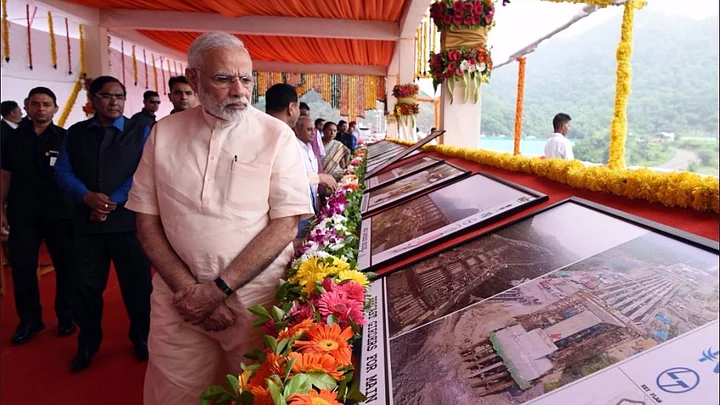Nearly 56 years after its foundation was laid, the Sardar Sarovar Dam, which was mired in controversies and faced stiff opposition from affected villagers, on 17 September became a reality with Prime Minister Narendra Modi dedicating it to the nation.
Modi unveiled the plaque dedicating the mega project to the nation, amidst chanting of vedic hymns by students.
The PM hit out at the opponents of the project, primarily the Narmada Bachao Andolan and the Congress, without naming them, stating that the “engineering marvel” had to overcome a “torrent of conspiracies” and unfounded rumours to finally get completed 50-years after it began, as the Times of India reported.
At a rally in Dabhoi, around 60 km from Kevadiya, the PM said:
No other project in the world has faced as many hurdles as the Sardar Sarovar Dam. But we were determined to complete the project...There was a tirade of false allegations at us and several conspiracies were hatched to stall this project. But we were determined to not make it a tool for political disputes...I have a kachcha chittha (detailed account) of all those who tried to stall this project, but I will not name them as I don’t want to indulge in political mudslinging.
He further recalled how the World Bank did a U-turn on funding the project, as a massive misinformation campaign emerged on its environmental impact.
But we were determined.. World Bank or no World Bank... will ensure that the dam is built.
Union Minister Nitin Gadkari and Gujarat Chief Minister Vijay Rupani were among the dignitaries present on the occasion.
The foundation stone of the dam, which could prove to be a boon for the people of the state’s perennially-parched areas like Saurashtra, Kutch and North Gujarat, and even few districts of Rajasthan, was laid on 5 April 1961 by first the country’s first Prime Minister, Jawaharlal Nehru.
However, it took 56 years to finally complete its construction due to court cases and protests by the affected villagers.
The project was mired in many controversies and faced impediments from pro- and anti-dam activists, till finally the Supreme Court gave the nod for its construction in 2000.
The dam on River Narmada has been described as 'Gujarat's lifeline' by the BJP leaders, as it aims to provide drinking water to 131 urban centres and 9,633 villages (53 percent of total 18,144 villages of Gujarat) and irrigation facilities for 18.54 hectares of land covering 3,112 villages under 73 talukas in 15 districts.
Modi’s visit, which has added significance as Assembly elections are due in Gujarat by the year-end, is the second in less than a week after he hosted Japanese Prime Minister Shinzo Abe in the state and launched the bullet train project.
Earlier, the Prime Minister had stressed that the project will start a new chapter of prosperity for Gujarat.
After its inauguration, there was a dispute between Gujarat and Madhya Pradesh on the sharing of the water and electricity.
(This story has been edited for length)
(At The Quint, we question everything. Play an active role in shaping our journalism by becoming a member today.)
